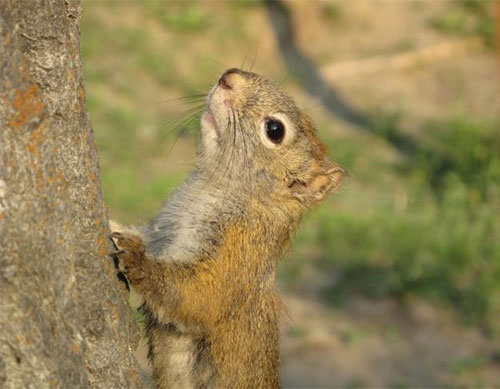Alaska Science Squirrels somehow predict seed bonanzaBy NED ROZELL
March 27, 2017
Boutin, of the University of Alberta in Edmonton, was in Fairbanks recently to give a lecture on one of the easiest-to-find animals in the boreal forest. The square-jawed biologist is perhaps the world’s foremost expert on red squirrels.
A red squirrel pauses on a tree. A researcher in the Yukon has discovered that red squirrels increase their litter numbers in summers before white spruce trees produce more seed cones, the species’ primary food.
Here are some insights from three decades of observations of more than 10,000 individuals: Though one squirrel on his plot lived to be nine years old, few live past four. Most don’t survive their first year. Squirrels spend their entire lives in a small patch of forest surrounding a midden, a pile of spruce cones with tunnels and chambers throughout. When squirrels rattle off their call, they are signaling their possession of a small territory centered on a midden. Mother squirrels sometimes bequeath their territory to a pup and move one or two territories over where there is a vacancy. Sibling squirrels sometimes share nests on cold nights, then go back to their own territories when temperatures warm. Squirrels eat a lot of things, including nestling songbirds and snowshoe hare babies, but the largest part of their diet by far is white spruce seeds. White spruce trees produce great pulses of cones every two to six years. Other years, trees grow no cones. Boutin figures the trees create so many cones suddenly to “swamp” predators like the red squirrel, ensuring that some seeds remain to germinate into trees. These “mast years” of high cone production should give spruce trees the element of surprise. Squirrels should react with a delay, having many babies the year after many cones pop up. But female squirrels seem to be outsmarting the trees. “All hell breaks loose in a mast year,” Boutin said. “Reproduction absolutely explodes.” In a normal year, squirrels have one litter of pups and don’t try again. When spruce cones are abundant, females will have two litters and sometimes breed until the end of summer, even though new cones don’t mature until September. “These buggers are cranking out reproduction when it’s ahead of masting reproduction,” Boutin said. How can female squirrels predict a good food supply before it exists? Boutin is not sure. Spruce trees produce buds in May that squirrels eat. Perhaps there is some chemical signal within the buds that triggers what Boutin calls “adaptive anticipation” within the tiny orange lords of the boreal forest.
Since the late 1970s, the University of Alaska Fairbanks’ Geophysical Institute has provided this column free in cooperation with the UAF research community.
Representations of fact and opinions in comments posted are solely those of the individual posters and do not represent the opinions of Sitnews.
|
||

